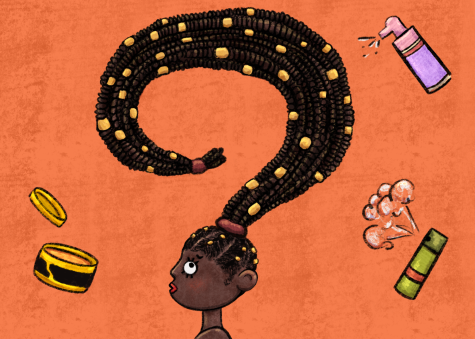Braids and bucks: Balancing the price of Black hair care and DIY alternatives
September 28, 2022

The summer before her freshman year of college, Torrie Bell, a senior acting major, shaved her hair.
“I was just like, ‘I can’t do this anymore,'” Bell said, after having to keep her hair in tight updos for years due to being a dancer. “My hair was kind of damaged from always having to flat iron and then trying to twist it up, and it’s just like, ‘This is not working.'”
In college she began to experiment with her hair. Bell tried different colors and styles, ranging from simple twist-outs and space buns, to black and blue box braids.
“The moment I could put it in braids, I did,” Bell said. “I just started doing different things with my hair, because I didn’t have that chance in high school.”
With YouTube as her guide, Bell learned how to braid her own hair. Though she would occasionally get advice from a cousin, when starting out she relied on herself.
“I first started out with the rubber band method and then crocheting it, crocheting the hair and then braiding it,” Bell said. “And now I’m at a point where I can just go ahead and part it and go and just go.”
Bell said she finds the “do-it-yourself” approach more freeing because it gives her the chance to switch up her style without worrying about breaking the bank.
“The prices that braiders now want are outrageous, and it’s not conducive to the lifestyle of a college student who’s very broke,” Bell said.
For junior fashion merchandising major Breyona Smith, trying new styles helped her explore her hair’s versatility.
“I never got box braids until 2020, and then once I started doing that, then I fell in love more [with my hair],” Smith said.
Hair is “super important,” Smith said, as it’s both cultural and personal, and can be a source of pride and creativity.
For Black students at Columbia, simply finding the right products and stylists can be challenging for several reasons.
Smith said she has found some success finding products at stores like CVS, Target and even Burlington. To find a beauty supply store, though, she said students may have to leave the Loop.
“People will be like, ‘Go to Sally’s,'” Bell said, referring to the chain store, which has one located at 24 E. Madison St. “I’m like, ‘No, Sally’s is not a beauty supply.'”
Beauty supply stores, which stock products specific to Black hair care, are few and far between in the South Loop area, said Claudette Harris, who is a sophomore illustration major.
“I was living in the dorms my first year, [and] it was hard to find a beauty supply downtown,” Harris said. “Yeah, I could go to Target, but they only have so much.”
Beauty One Inc., located at 616 W. Roosevelt Road, which is a 10-minute, two-transfer bus ride from campus, is a go-to shop for Bell, who said it is convenient to get to.
Harris said they found Beauty One Inc. too small and said they even once traveled 30 minutes on the bus in search of a store that carried the hair care products they needed.
For some, coming to college disrupts a regular hair routine, and they have to adjust. Students who are new to Chicago no longer have access to the stores and stylists they would at home. For others, it is a challenge to find the time between classes and homework.
Compared to high school, Smith said it has been more difficult to find the time to do her hair in college, and time management is key.
“I know if I’m going to straighten my hair, it’s basically going to take all day,” Smith said. “Finding the time takes a while, but gets easier with practice.”
Throughout middle and high school, Shayle Cruz, a sophomore music business major, said she went to the same hairdresser and got the same style.
“Once I got to Chicago last year, I figured that wasn’t sustainable because I didn’t have enough money to be spending on getting my hair done all the time, and I didn’t really have the time or energy to do it myself,” Cruz said.
Instead of ironing it straight, she decided protective styles like braids were the way to go.
At first, Cruz got her braids done by a friend, after a trip to a professional braider, which she said was “not the best” experience.
When that friend transferred, she was at a loss and turned to the Engage app, where she successfully found another student braider. Cruz said getting help from a peer was the way to go.
“If you see someone in your class who has their hair braided, then you can go up and ask them if they do braids, or if you can, ask them where they got theirs done or if they have any suggestions,” Cruz said.







